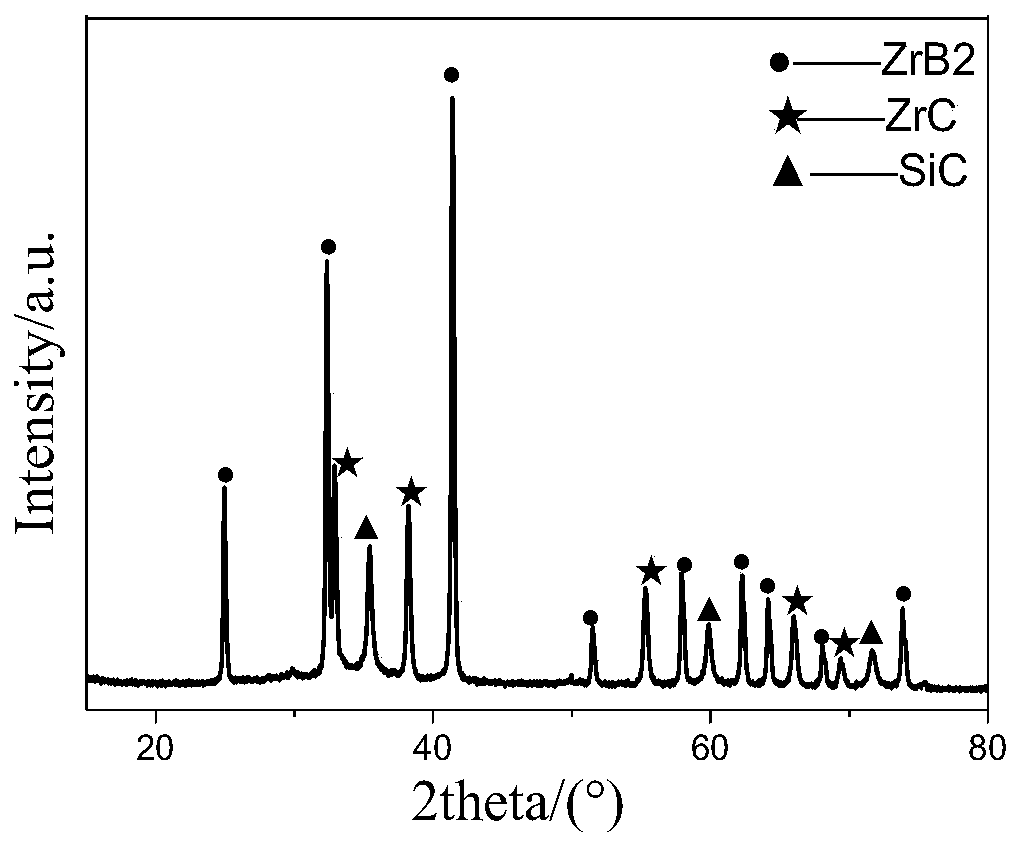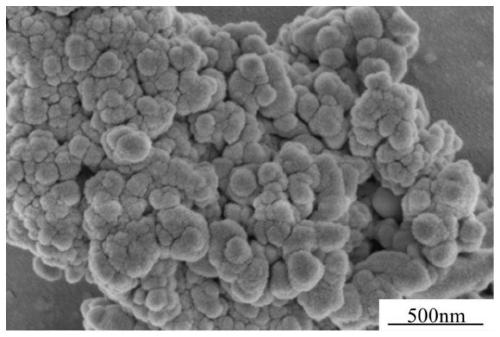Preparation process of ZrC-ZrB2-SiC ceramic composite powder by precursor conversion method
A zrc-zrb2-sic, ceramic composite technology, applied in the field of inorganic non-metallic materials, can solve the problems of easy oxidation of raw material powder, easy introduction of oxide phase, insufficient in-situ reaction, etc., to achieve short cycle and low cost , evenly distributed effect
- Summary
- Abstract
- Description
- Claims
- Application Information
AI Technical Summary
Problems solved by technology
Method used
Image
Examples
Embodiment 1
[0018] A ZrC-ZrB 2 -Precursor conversion method preparation process of SiC ceramic composite powder, the specific process is as follows:
[0019] (1) Step 1: According to the amount ratio of substances, it is boric acid: zirconium oxychloride octahydrate: ethyl orthosilicate=4:1:2, and the mass ratio of glucose: ethyl orthosilicate=2.5:1, weighed respectively Zirconium oxychloride octahydrate, boric acid, ethyl orthosilicate, and glucose for later use.
[0020] (2) Step 2: Under the condition of continuous magnetic stirring, dissolve zirconium oxychloride in absolute ethanol, add hydrogen peroxide dropwise, and prepare a uniform and transparent solution, that is, zirconium precursor solution. Dissolve boric acid in absolute ethanol, heat in a water bath until completely dissolved, and prepare boric acid solution. Dissolve ethyl orthosilicate in absolute ethanol to prepare ethyl orthosilicate solution. Glucose was dissolved in deionized water to prepare a glucose solution. ...
Embodiment 2
[0023] A ZrC-ZrB 2 -The preparation process of the precursor conversion method of SiC ceramic composite powder, except that the following heat treatment temperature is different, all the other are the same as embodiment 1.
[0024] In this embodiment: the amount ratio of the raw materials taken is boric acid: zirconium oxychloride octahydrate: ethyl orthosilicate=4:1:3, mass ratio glucose: ethyl orthosilicate=2:1; heat treatment The temperature is 1600°C.
Embodiment 3
[0026] a ZrB 2 -The preparation process of the precursor conversion method of SiC ceramic composite powder, except that the following heat preservation time is different, all the other are the same as embodiment 1.
[0027] In the present embodiment: the amount ratio of the raw materials taken by weighing is boric acid: zirconium oxychloride octahydrate: ethyl orthosilicate=3:1:2, mass ratio glucose: ethyl orthosilicate=2:1; 2h.
[0028] From figure 1 It can be seen that the phase composition of the composite ceramic powder prepared by the preparation process of the present invention is pure ZrC, ZrB 2 And SiC, the degree of crystallinity is high, and no other impurity phases exist.
[0029] From figure 2 It can be seen that the ceramic phase of the composite ceramic powder prepared by the preparation process of the present invention is irregular and granular, with a uniform particle size and a flat particle size of about 150 nm.
PUM
| Property | Measurement | Unit |
|---|---|---|
| particle size | aaaaa | aaaaa |
Abstract
Description
Claims
Application Information
 Login to View More
Login to View More - R&D
- Intellectual Property
- Life Sciences
- Materials
- Tech Scout
- Unparalleled Data Quality
- Higher Quality Content
- 60% Fewer Hallucinations
Browse by: Latest US Patents, China's latest patents, Technical Efficacy Thesaurus, Application Domain, Technology Topic, Popular Technical Reports.
© 2025 PatSnap. All rights reserved.Legal|Privacy policy|Modern Slavery Act Transparency Statement|Sitemap|About US| Contact US: help@patsnap.com


